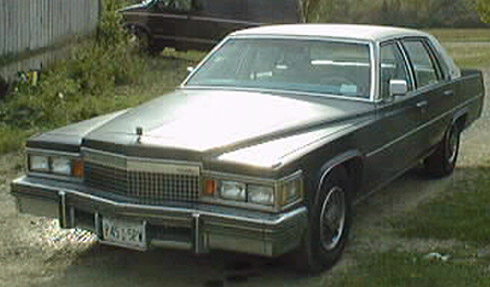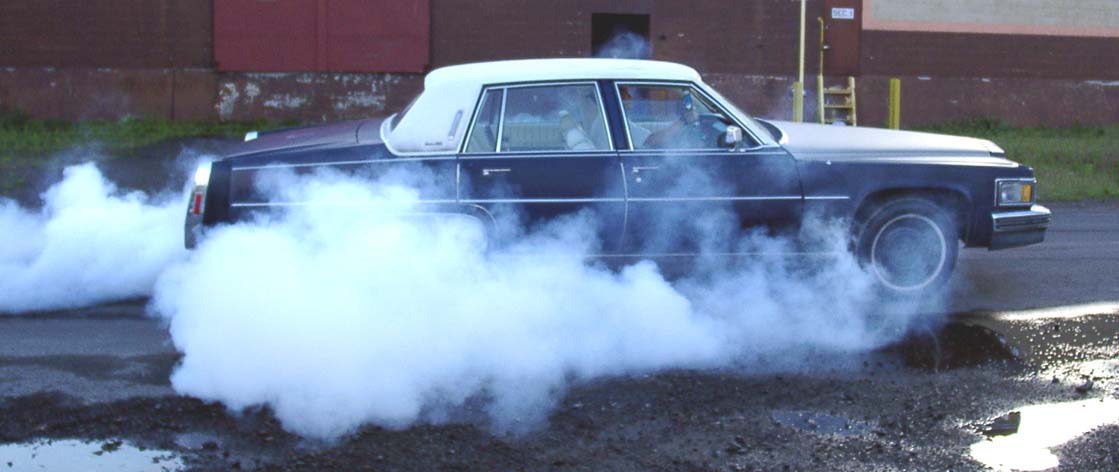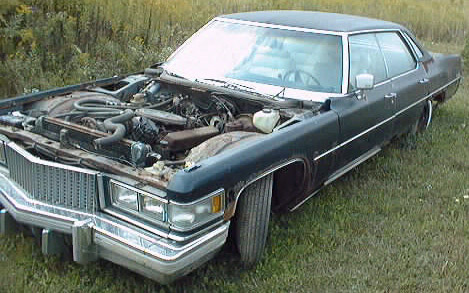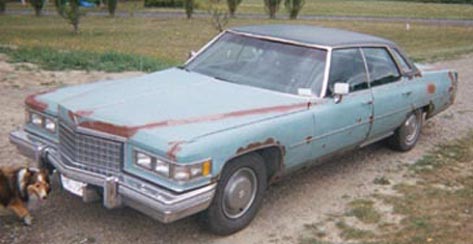My car is a dark metalic blue 1979 Cadillac Sedan DeVille, it has over 119,000 miles on it now, I have put only 8,000 on it since I got it. It got about 17 MPG on the highway, and 11 MPG in the city, with the stock 425. I know it is no hot rod car, but it has a lot of potential for many reasons. First of all it has a large reliable 425 cu. in. (7.0 liter) Big-Block to work from, which is interchangeable with the 368,472,500 Cadillac engines! Second it is backed by a rugged TH-400 3-speed transmission, along with the famous GM 10-bolt rear that was used on millions of other cars! Another reason it has such good hot rod potential is because it is a Cadillac! How many fast powerful Cadillacs do you see out there? There are thousand of Cadillacs out there that look just like mine, but they won't be half as powerful after I get done with mine!
I plan on installing performance parts, but make the Ol' Cad a big Hot Rod Sleeper looking car.
My dad purchased the car for me in March of 1997 from a couple in Horseheads, NY for $800. This isn't the cheapest you can get one of these 70's or even 80's Cadillacs, but it is in great shape and is a steal at $800, and it is a cheap start for a hot rod sleeper! I am the third owner, and I found out the first owner lived in PA, and traded in her 76' Sedan DeVille with only 23,000 miles on it for my new 79' Sedan DeVille. The body is in great shape, the paint is a little weathered, but the chassis and engine/tranny run beautifully.
The car needed minor work to get it ready for inspection, like fixing the front passenger side body filler, which lost a bolt, and rubbed against the tire. After I fixed up everything that was needed for inspection, I had the car registered in August 97'.
The interior of the car is also in great shape, it has white leather seats, light blue carpet, and an AM/FM 8-track player that still worked! I installed a new power antennae, which I got at Radio Shack for $30.
The only thing wrong with the interior was the headliner, which was missing. I purchased a new one for about $120.
The first major move towards hot rodding my Cadillac was a tune-up. I started by changing the spark plug wires (which I believe were the originals), distributer cap and rotor, and I installed 8 new AC Delco Rapidfire spark plugs. After the tune up I installed a Accel High Energy HEI coil. After driving it around with just these Hi-Po improvements
I decided to rebuild a Q-jet I got from the local junk yard, Pick-a-Part, for $17. It needed a new float $6, a rebuild kit $11, and new front and rear vacuum breaks $40. I planned on rebuilding the carb with performance in mind, so a complete cleaning and inspection was needed, along with the rebuild. I also decided to improve airflow by grinding down all the casting marks in the primary and secondary bores.
After I installed my new rebuilt Q-jet, I was amazed at the performance increase! This was primarily due to the fact that the secondaries on the original carb did not open all the way, and I also think the airflow improvements I made also helped. I knew I had more power by how much easier it was for the torque monster to spin the rear wheels.
I was planning on installing Hooker Headers #2455 $166, which are for the big-block chevy, and I purchased a header flange kit from Cadillac Motorsports Development for $70. This allows the BB Chevy headers to bolt to the Cadillac 425/472/500 engine heads. I could not get these to fit the tight engine bay of the 79, so I am looking into installing Sanden block hugger headers.
I also plan to install a 72 GPH Carter Electric fuel pump $45, to feed the hungry 472, with a canister type fuel filter, I am also using a fuel pump block-off plate, which I also purchased from CMD for $20. This is all going to get fuel from a 16 gallon fuel cell mounted in the trunk.
For the TH-400 tranny I installed a shift improver kit $25, and a chrome fluid pan with a drain plug.
I was seriously considering nitrous oxide on the 425 for an extra 150 hp, and then I would get lots of power easily right?, WRONG!!! Through my research I found out the the 425 uses a lighter therefore weaker crankshaft than the 472,500, I have heard many horror stories of people snapping the crank on their 425 by racing it or adding nitrous. I quickly decided that my only option was to install the 1972 472 that I was considering earlier, and then possibly add massive doses of nitrous because this engines crank can handle it!!!! So, I went to Pick-A-Part ( My home away from home!) on the hottest day of April, and pulled a 472 myself. The donor car is a 1972 Cadillac Fleetwood Brougham, a very large Luxo-barge! The 472 had only 98,066 miles on it and it was in there because the car frame had rusted out. The engine was $50 plus some torching and impact wrenching that was needed to get the motor mounts and exhaust off, which added to the price along with a core charge. The total price came to $166. I got the engine home and on the stand and began
to take apart the oil leaking grease ball. I was amazed at how clean the inside of the engine was, there was almost no wear in the cylinders, almost no carbon deposits on the heads or pistons! My plans are to inspect the engine futher, check tolerances, hone out the cylinders and install new oil pump, water pump, and timing chain set, bearings, piston rings and top it off with a good gasket set. I will then add a new coat of Cadillac light blue paint to make it look like the less powerful 425, to maintain the sleeper look on the inside of the car. Then with the headers, dual exhaust system, Edelbrock performer intake manifold, Holley 780 carb, Competition cam and other modifications like milling down the heads to raise the compression, I estimate the new total power of this Luxo-barge to be close to 430 Horsepower!




